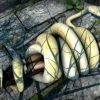How to create realistic creature python-jaw-animation-mechanics-how-to-animate-realistic-snake-feeding-sequences/”>animation involves understanding anatomy, motion capture techniques, and 3D software mastery. This comprehensive guide covers the essential steps to bring mythical creatures and monsters to life through professional 3D animation.
At Merciless Nature, we’ve spent over a decade perfecting creature animation techniques that bring dragons, dinosaurs, and fantasy beasts to life with stunning realism.
What is Realistic Creature Animation?
Realistic creature animation is the art of creating lifelike movement and behavior for fictional beings, monsters, and fantasy creatures using 3D animation software. Professional creature animators combine biological knowledge, motion physics, and artistic vision to produce believable character performances that captivate audiences.
Essential Tools for Creature Animation
- Cinema 4D – Industry-standard for motion graphics and creature animation
- Blender – Free, powerful 3D creation suite with advanced rigging
- Maya – Professional choice for film and game creature animation
- Houdini – Advanced procedural animation and effects
- Poser – Figure-focused animation for humanoid creatures
For a detailed comparison of these tools, check out our comprehensive software comparison guide.
Step-by-Step Creature Animation Process
1. Research Real-World Animal Anatomy
Study how real animals move. Dragons can be based on reptilian movement patterns, while griffins combine bird and feline locomotion. Understanding skeletal structure, muscle groups, and weight distribution is critical for believable animation.
Pro tip: Watch nature documentaries and study real predator behavior. Our T-Rex animations are based on extensive research of bird biomechanics and crocodilian hunting patterns.
2. Build a Proper Skeleton Rig
Create an anatomically correct bone structure in your 3D software. Include:
- Spine segments for realistic flexibility
- IK/FK switches for legs and arms
- Tail controls with multiple segments
- Wing rigging with proper joint hierarchy
- Facial controls for expressions
3. Master Weight Painting
Properly weighted vertices ensure smooth deformation. Pay special attention to joint areas like shoulders, hips, and necks where deformation is most visible. Use gradient weight painting for natural muscle bulging and skin sliding.
4. Apply Physics and Secondary Motion
Add realistic physics simulations for:
- Skin jiggle and muscle dynamics
- Hair and fur simulation
- Wing membrane flutter
- Tail follow-through
- Saliva and drool effects
See these techniques in action in our Ogre animation series, which showcases advanced physics simulation.
5. Animate Walk Cycles and Behaviors
Create foundation animations including walk cycles, run cycles, idle behaviors, and attack animations. Study reference footage of real animals performing similar actions. Dragons should show weight in their movements, while smaller creatures need quicker, more nervous animations.
Common Creature Animation Mistakes to Avoid
- Floating movement – Always show weight and gravity impact
- Uniform timing – Vary animation speeds for different body parts
- Stiff poses – Add subtle movement even in “still” frames
- Ignoring anticipation – Build up before major actions
- Unrealistic scaling – Maintain consistent proportions throughout movement
Advanced Techniques for Professional Results
Motion Capture Integration
Use motion capture data as a foundation, then hand-key additional details. Actors can perform basic locomotion patterns that you enhance with creature-specific movements like tail swaying or wing adjustments.
Procedural Animation
Implement procedural systems for repetitive tasks like breathing, blinking, and subtle weight shifts. This creates natural variation without manual keyframing every frame.
Camera Work and Cinematography
Frame your creature animations dramatically. Use low angles to emphasize size and power, eye-level shots for character connection, and dynamic camera moves to enhance action sequences.
Rendering and Post-Production
High-quality rendering elevates your animation:
- Lighting – Use three-point lighting to sculpt forms
- Materials – Create realistic textures with subsurface scattering for skin
- Rendering engines – Octane, Cycles, or Arnold for photorealistic results
- Compositing – Add depth of field, motion blur, and color grading in post
Real-World Examples and Portfolio
Want to see these techniques in professional productions? Browse our collection:
- Vore Out 2 – Advanced creature interaction and physics
- The Rampage – Large-scale destruction and creature weight
- Snake animations – Flexible spine rigging and coiling mechanics
Frequently Asked Questions
How long does it take to create a creature animation?
A simple creature animation (10-15 seconds) takes 40-80 hours including modeling, rigging, animation, and rendering. Complex animations with detailed creatures can require 200+ hours depending on quality requirements. Our professional team at Merciless Nature typically spends 100-300 hours per premium animation to ensure cinematic quality.
What is the best software for beginners?
Blender is recommended for beginners due to its free availability, extensive tutorials, and professional-grade features. Cinema 4D offers a more intuitive interface but requires a paid license. Read our complete software comparison to make an informed choice.
Do I need drawing skills for 3D creature animation?
While not strictly required, understanding anatomy through drawing significantly improves animation quality. Many professional creature animators sketch extensively to plan poses and understand form. We recommend practicing gesture drawing and anatomy studies alongside 3D learning.
Conclusion
Mastering realistic creature animation requires dedication to studying anatomy, practicing animation principles, and continuously refining your technical skills. Start with simple creatures and gradually tackle more complex designs as your abilities grow.
Ready to see professional creature animation in action? Explore our complete collection of dragon, monster, and fantasy creature animations created using these exact techniques. For more animation insights, check out our guide on understanding vore animation as a specialized animation niche.



Add comment
You must be logged in to post a comment.